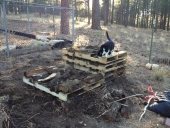
 3
3




 6
6




George Mogil wrote:Hello!
So I plan to partition pieces of growable terrain, remove manually any snow cover, place a black fabric that heats up the soil by absorbing the sunlight in an attempt to thaw out the soil still frozen down to the frostline. After this happens, work the soil and plant seeds or seedlings started indoors and hardened. To help the seedlings along, replace the black fabric with a commercial white fabric that protects during the cool nights by shielding and maintaining a higher temperature and removing it during the day.
In the event of a killer frost (sometimes either in early June or early August), smudge fires (in barrels) that produce a lot of smoke can be used.
The growing season here is 60 - 90 days June to August, postal code J0R 1H0 in Canada, but I'm in the hilly country about 1000 feet altitude. We have a 6 month winter season.
Anyone using this or similar technique, please comment and mention the type of fabric used (could it be burlap?), the brand or other commercial product or even a home made cover?).
A build too cool to miss:Mike's GreenhouseA great example:Joseph's Garden
All the soil info you'll ever need:
Redhawk's excellent soil-building series





 3
3




Invasive plants are Earth's way of insisting we notice her medicines. Stephen Herrod Buhner
Everyone learns what works by learning what doesn't work. Stephen Herrod Buhner
 9
9




"When the whole world is running towards a cliff, he who is running in the opposite direction appears to have lost his mind." C.S. Lewis
Visit https://themaineingredient.com for organic, premium dried culinary herbs that are grown, processed, and packaged in the USA.
 7
7




 6
6





Katherine
 4
4




I want to be 15 again …so I can ruin my life differently.
 5
5




 5
5




 4
4




 2
2




Ben Polley wrote: I also grow potatoes in plastic growbags
 4
4




$10.00 is a donation. $1,000 is an investment, $1,000,000 is a purchase.
 3
3




 3
3




JayGee
 2
2




 2
2




 4
4





|
My cellmate was this tiny ad:
Learn Permaculture through a little hard work
https://wheaton-labs.com/bootcamp
|



